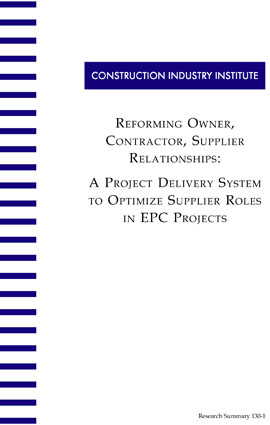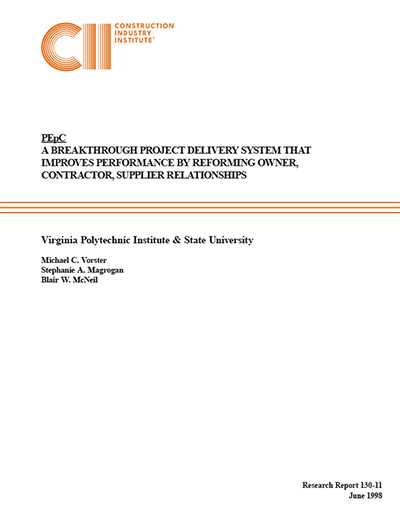
Reforming Owner, Contractor, Supplier Relationships: A Project Delivery System to Optimize Supplier Roles in EPC Projects
By expanding its membership to include suppliers, CII recognizes that suppliers of key engineered systems and components can and should play a significant role in the pursuit of CII goals. CII, therefore, established the Reforming Supplier Relationships Research Team to explore the potential for reforming traditional owner/contractor/supplier relationships in engineer-procure-construct (EPC) projects to enhance the ability of suppliers to contribute more meaningfully to this process.
Believing that a breakthrough approach would be required to facilitate such a reformation, this research team concluded that if the role of suppliers of the most critical components and systems in a project is to be enhanced, then one must both enhance and prioritize the point of definitive contact with those suppliers: the procurement process. A new project delivery system was envisioned that divides the procurement process into “big P”—strategic procurement items, including complex engineered equipment and systems essential for project performance, and “little p”—the balance of items to be procured; and then reconfigures the traditional EPC model into Procurement, Engineering, procurement, and Construction, or PEpC.
In traditional EPC, procurement follows engineering, both sequentially and in the fact that engineering specifies and defines the items to be procured. In PEpC, the most strategic and project-critical procurement transactions occur prior to detail engineering, and those procured items then influence and define subsequent detailed engineering. Further, the core competencies of the supplier, which are often unique and beyond those possessed by either the owner or contractor, are provided directly into the project delivery system.
Utilizing a sophisticated simulation model of the classic EPC process, the research team compared the impact of a PEpC approach to project execution with traditional EPC. In both theoretical and field implementations, the results indicated that PEpC could produce savings in excess of 10 percent to 15 percent of the time and four to eight percent of the cost of the traditional EPC process.
- The need exists to bring suppliers of strategic components and systems into the “circle of cooperation” between owners and contractors, and precedents for doing so exist.
- In numerous cases, suppliers served an expanded project role (status and/or time involvement beyond that expected) despite narrowly and traditionally-defined business and commercial relationships.
- Pockets of innovation existed and provided strong anecdotal evidence of cost and time savings for doing so.
- Two industries—automotive manufacturing and micro-electronics fabrication—had improved results through expanded supplier involvement.
RS130-1, proposes a process for implementing the PEpC project delivery model, illustrating how it integrates with other project plan deliverables such as the business plan, facility scope, and project exeuction plan. PEpC must begin with and be incorporated into the earliest pre-project planning processes to be successful. Each implementation step is described in detail.



